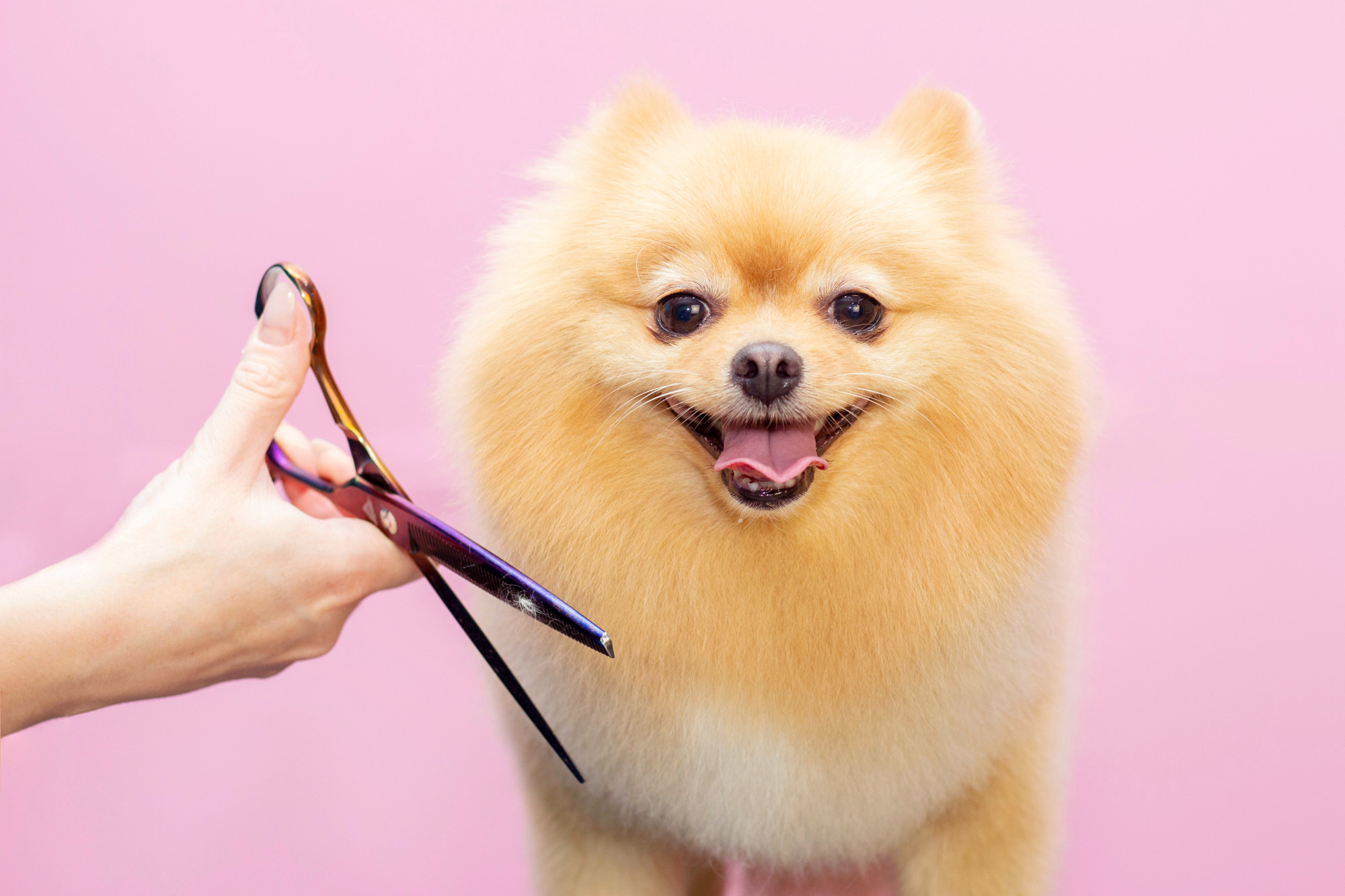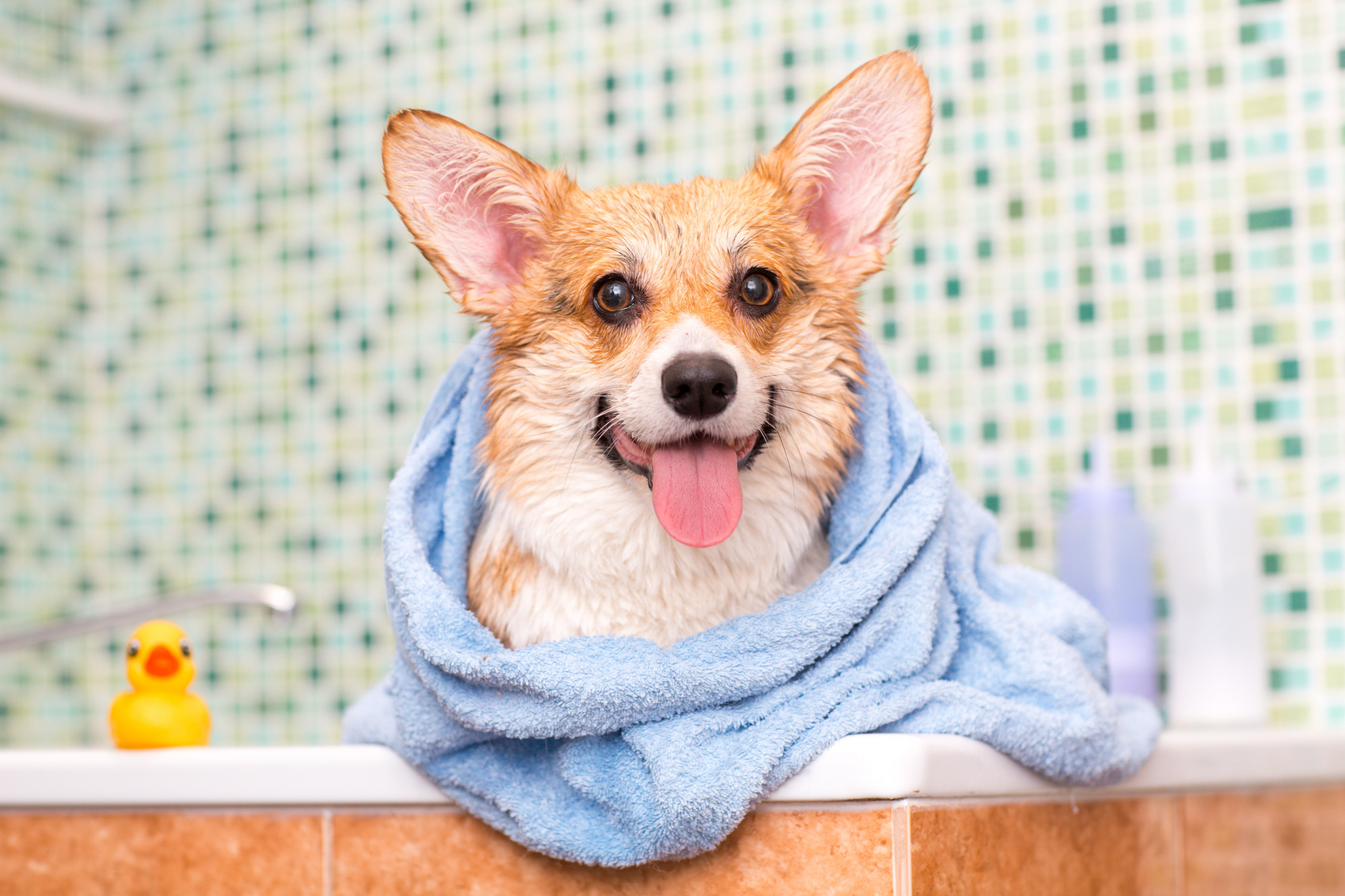Understanding the intricacies of dog grooming can be challenging for many pet parents, particularly when determining the optimal grooming frequency for their furry friends. A dog's grooming needs can vary greatly based on factors like hair length and type, with short-haired dogs requiring different care compared to long-haired breeds.
Furthermore, other factors such as the dog's coat characteristics, from silky hair to double-coated, smooth, or even wire-haired, can affect how often a dog should be groomed. Dog grooming extends beyond merely maintaining their appearance, playing a vital role in their overall health, particularly their skin condition.
This article comprehensively explains how often you should groom your dog, considering variations like medium-length hair, curly and wavy coats, and the significance of regular grooming appointments.
Whether you have a pet with lustrous long hair or a pup with a more austere dog's coat, knowing when to pick up the human nail clippers or make a trip to get your pet groomed will contribute significantly to your dog's well-being.
The Basics of Dog Grooming

The second section of this article outlines the fundamental tasks involved in dog grooming, catering to the diverse needs of short-haired dogs, long-haired dogs, double-coated dogs, and even wire-haired dogs. These crucial procedures encompass brushing, bathing, nail trimming, ear cleaning, and teeth cleaning, each carrying its respective advantages for a healthy coat and dog's skin.
Brushing is a paramount aspect of dog grooming as it helps distribute natural oils evenly throughout the dog's hair, be it silky hair, smooth hair, or the unique textures of double-coated and wire-haired dogs.
This process aids in removing tangles or mats that can cause discomfort, especially for long-haired dogs who may need more frequent grooming. Regular brushing also reduces shedding - a common occurrence where dogs shed their dead hairs - and promotes healthy skin, with minimal brushing required for short-haired dogs.
Bathing your dog every few months is essential, regardless of whether your pet groomed has silky-coated, double-coated, or wire-haired fur. This grooming procedure helps maintain proper hygiene, preventing skin infections caused by dirt or parasites. However, over-bathing can strip away the natural oils from your dog's skin, leading to dryness and irritation, a concern that pet parents should be aware of when maintaining a consistent grooming schedule.
Nail trimming is another important aspect of dog grooming that prevents your pooch's nails from growing too long, causing pain or difficulty walking. Likewise, ear cleaning removes excess wax buildup that can lead to infection, which is particularly relevant for certain breeds with long or silky hair that may trap more debris. Teeth cleaning, in its turn, helps to prevent dental problems such as tartar buildup and bad breath, further contributing to the overall health of your dog.

Incorporating these basic grooming tasks, attuned to your dog hair type and shedding patterns, into your routine will keep your pet looking good and ensure they stay healthy and comfortable. Whether you have a short-haired dog requiring less frequent grooming or a long-haired one needing more care, knowing how often and in what way to groom your dog is fundamental.
Factors Influencing the Frequency of Dog Grooming

This discussion will focus on the factors that influence the frequency of dog grooming. Breed-specific needs are a key consideration, as different fur types and shedding tendencies require varying levels of attention.
Age and health condition also play a role in determining grooming needs, with special considerations for puppies, older dogs, and those with specific health issues.
Lifestyle and activity levels can impact grooming needs, with indoor vs. outdoor dogs and physical activity levels playing an important role in determining how often grooming is necessary.
1. Breed Specific Needs
Different breeds of dogs require varying levels of grooming, as seen in the case of a Golden Retriever with long fur that needs daily brushing to prevent matting and a Chihuahua with short hair that only requires weekly grooming to maintain its coat.
Fur type is crucial in determining how often a dog should be groomed. For instance, dogs with long hair require more attention than those with short hair because their hair tends to tangle and mat easily. Curly-haired breeds such as Poodles also need frequent grooming since their coats are prone to tangling and matting.
Shedding tendencies also play an essential role in determining how often a dog should be dog groomed. Breeds that shed heavily such as German Shepherds and Labrador Retrievers need regular brushing to remove loose fur and prevent matting. On the other hand, non-shedding breeds such as Bichon Frise and Poodles require professional grooming every 4-6 weeks to keep their coats looking healthy and shiny.
2. Age and Health Condition of the Dog
Age and health condition are two factors that significantly impact a dog's grooming needs, requiring special attention for puppies and older dogs.
Puppies have delicate skin and fur, which need to be handled with care during grooming sessions. They require frequent brushing to prevent matting and tangling of fur, especially in long-haired breeds. Regular bathing is also necessary to keep their sensitive skin clean and healthy.
On the other hand, older dogs may have health conditions that affect their grooming needs. For example, arthritis may limit their mobility, making it difficult for them to groom themselves properly. Older dogs also tend to develop dry skin, which requires gentle cleaning and moisturization during grooming sessions.
Pet owners must closely monitor their dog's health condition as they age and adjust their grooming routine accordingly. By understanding these special grooming needs based on age and health condition, pet owners can ensure their furry friends remain healthy and happy through proper dog grooming practices.
3. Lifestyle and Activity Level
A dog's lifestyle and activity level can significantly impact its grooming needs. Dogs that spend most of their time indoors may require less frequent grooming than dogs that spend most of their time outdoors.
Indoor dogs are less likely to come into contact with dirt, debris, and other environmental factors that can contribute to matting, tangles, and skin irritation. However, indoor dogs still need regular grooming to maintain healthy coats and prevent mats from forming.
On the other hand, outdoor dogs typically require more frequent grooming due to environmental elements such as wind, rain, and sun exposure. Physical activity levels also play a role in determining a dog's grooming needs. Dogs that lead active lifestyles or participate in activities such as running or swimming may need more frequent baths and brushing to remove dirt and debris from their coat.
Pet owners must consider these lifestyle factors when determining how often they should groom their dogs to maintain optimal health and hygiene.
General Guidelines for Dog Grooming Frequency

General guidelines for dog grooming frequency include brushing, bathing, nail trimming, ear cleaning, and teeth cleaning. Brushing your dog regularly helps to remove loose hair and distribute natural oils throughout its coat, resulting in a shiny and healthy-looking pup.
The brushing frequency will depend on your dog's breed and coat type. Dogs with longer coats require more frequent brushing than those with shorter coats. Generally, dogs with short hair should be brushed once a week while those with long hair may need to be brushed daily.
Bathing your dog is also important but should not be done too frequently as it can strip the natural oils from their skin and coat. The frequency of bathing will depend on your dog's lifestyle and activity level.
Dogs that spend more time outdoors or are very active may need to be bathed more frequently than indoor dogs that are less active. As a general guideline, most dogs only need to be bathed every three months or so unless they get dirty or smelly in between baths.
Nail trimming should also be done regularly to prevent overgrowth which can cause discomfort or even lead to infection if left unchecked. Ear cleaning should also be part of your regular grooming routine as it helps prevent infections by removing dirt and excess wax buildup from the ears.
Professional Grooming vs. Home Grooming
Professional grooming and home grooming are two options for maintaining your dog's appearance and hygiene, each with its own advantages and disadvantages. Professional grooming is ideal if you have a busy schedule or don't have the necessary tools or knowledge for proper grooming.
A professional groomer has extensive training in handling different breeds of dogs, using specialized tools, and identifying potential health issues that may require veterinary attention. Moreover, they can provide services such as haircuts, styling, nail trimming, ear cleaning, and teeth cleaning that are beyond the scope of what most pet owners can do at home.
On the other hand, home grooming has its benefits too. It allows you to bond with your dog while keeping them clean and healthy without spending much money on professional services. Additionally, it gives you control over the products used on your pet's skin and coat, so you can choose natural or hypoallergenic options if your dog has sensitive skin.
However, before embarking on home grooming adventures, it is essential to invest in quality equipment such as brushes, combs, clippers (if needed), shampoo (for dogs), conditioner (optional), nail trimmers (with guard), ear cleaner solution or wipes (depending on breed type), toothbrushes/toothpaste formulated for pets' oral health needs- this will ensure a successful outcome!
Understanding and Recognizing Grooming-Related Problems
Now that we have explored the differences between professional grooming and home grooming, it is important to understand the potential issues that can arise from improper grooming.
Grooming-related problems can range from mild skin irritation to serious ear infections. As a responsible pet owner, it is essential to recognize these issues early on and take the necessary steps to address them.
Common signs of grooming-related problems may include excessive scratching or licking, redness or inflammation of the skin, foul odor coming from the ears, or discharge and swelling around the eyes. If you notice any of these symptoms in your dog, it is crucial to take immediate action. Consult with your veterinarian for a proper diagnosis and treatment plan.
Sometimes, you may need to adjust your grooming routine or use different products specifically formulated for your dog's needs. By recognizing and addressing grooming-related problems early on, you can help ensure your furry friend stays healthy and happy for years to come.
What are the health benefits of dog grooming?
Regular dog grooming has been associated with various health benefits for canines. Here are some of the advantages that come with proper dog grooming:
- Healthy skin and coat - Regular brushing and bathing help remove dirt, dead hair, and dander from your dog's fur, keeping their skin clean and healthy. This can prevent skin irritations and infections caused by built-up bacteria or fungi.
- Prevents matting - Matting occurs when a dog's fur becomes tangled or matted together, causing discomfort, pain, and even skin irritation. Regular grooming helps to prevent matting by removing any tangles before they become too severe.
- Early detection of health issues - Grooming provides an excellent opportunity to check your dog's body for any abnormalities such as lumps or bumps that may be indicative of underlying health issues. By detecting them early on through regular grooming sessions, you can take proactive steps to address them before they worsen.
Regular dog grooming is essential for maintaining a healthy pet. It not only improves their physical appearance but also promotes good physical health by preventing potential problems from arising in the first place.

Frequently Asked Questions
How often should a short-haired dog, like Boston Terriers, be groomed?
Short-haired dogs like Boston Terriers require fewer grooming sessions than their long-haired counterparts. They usually need brushing once a week to remove loose hair and occasional baths every month or so to maintain their coat and skin health.
However, their nails should be checked and trimmed regularly, typically every 3-4 weeks, and a professional groomer visit can be scheduled every 6-8 weeks.
Do long-haired dogs need more frequent grooming than other breeds?
Yes, long-haired dogs need more frequent grooming than other breeds. Their long, silky, or wavy hair is more prone to matting and tangling, requiring daily brushing to keep their coat neat and prevent skin issues.
Furthermore, these dogs often need their coat trimmed every 4-6 weeks, depending on coat length, to maintain a comfortable and manageable length. Regular visits to professional groomers are usually necessary for successful grooming.
How do silky-coated dogs' grooming needs differ from those with thick undercoats?
Like many Spaniel breeds or Yorkshire Terriers, silky-coated dogs require daily brushing to prevent tangles and mats in their fine hair. They also need their coat trimmed regularly, usually every 4-6 weeks, to keep it manageable.
On the other hand, dogs with thick undercoats, such as Huskies or German Shepherds, need regular brushing to remove loose undercoat hair, especially during shedding seasons. These breeds typically require fewer grooming sessions to trim their coat but may benefit from professional groomer visits to manage their undercoat.
What special grooming considerations are necessary for Poodle mixes or other dogs with curly or wavy hair?
Poodle mixes or other dogs with curly or wavy hair require frequent brushing, sometimes even daily, to prevent their hair from matting and tangling. These dogs often need their hair trimmed every 6-8 weeks to keep their coats tidy.
Due to the complexity of maintaining their coat, regular visits to professional groomers are often recommended for these breeds. Moreover, these dogs may need specific types of brushes or grooming tools to navigate their unique coat type effectively.
How does regular grooming contribute to a pet's health?
Regular grooming significantly contributes to a pet's health. It keeps a dog's coat clean and manageable and allows pet parents to check for skin issues, parasites, or abnormalities that may go unnoticed. Brushing stimulates the skin and improves blood circulation, promoting a healthier coat.
Regular nail trimming prevents walking difficulties and joint issues. Teeth cleaning is also a part of grooming, contributing to better oral health. For dogs with silky coats, long hair, or thick undercoats, grooming helps prevent matting and tangling, which can cause skin irritation or infection. Overall, grooming is integral to maintaining your pet's overall health.
Conclusion
Understanding dog grooming and how often you should groom your dog is a crucial part of pet ownership that contributes significantly to the health and comfort of your furry friend. Whether they're short-haired dogs with fewer grooming needs or breeds dogs with silky coats that require extra grooming, a balanced and regular grooming routine is paramount.
Many dogs, especially those with double coats, benefit from thorough undercoat removal and regular brushing of loose hairs with tools like a slicker brush, making pet grooming easier and more successful.
Remember to trim your dog's nails routinely and keep hair longer or shorter based on the breed's specific needs. The goal is to have your pet groomed for aesthetic appeal and to ensure their overall wellbeing. Through proper grooming your dog, we can cultivate a bond with our pets, learn more about them, and ultimately provide them with a life full of comfort and love.




